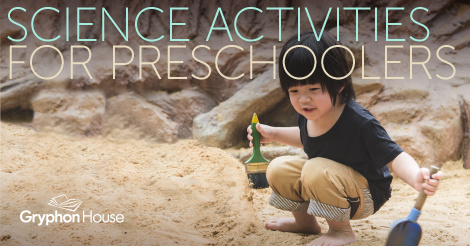Preschool science activities are a great way to have some fun with your little learners while introducing important science concepts to them that will help them grow and explore the world around them. Science for kids isn’t just reserved for the classroom either! Both parents and teachers can do fun science activities at home and school.
Preschool science activities are a great way to have some fun with your little learners while introducing important science concepts to them that will help them grow and explore the world around them. Science for kids isn’t just reserved for the classroom either! Both parents and teachers can do fun science activities at home and school.
The GIANT Encyclopedia of Science Activities for Children 3 to 6 is a wonderful parent and teacher resource full of science experiments that are easily adaptable for both home and school.
Here are 5 fun science activities your preschooler won’t be able to get enough of!
Across the Water
Ages 3+
Science Skills: Children use observation to identify differences and recognize similarities, and they see how cause and effect works.
Materials
- Jelly roll pans, or any flat metal or plastic lid with sides
- Water
- Styrofoam packing pieces
- Food coloring
What to do
1. Place each pan on a table.
2. Pour in a small amount of water to cover the bottom of the pans.
3. The children can make ripples on the water by blowing gently. Give a name to this wind (gentle breeze, light wind).
4. Two children can stand across the table from each other and blow pieces of Styrofoam back and forth. Investigate to find out what other objects can be moved by the wind on the water.
5. Observe the change in the water as you add drops of food coloring. Swirl the water around and watch as it gradually turns a different color.
6. Compare gentle wind to strong wind by letting two children stand on the same side of the table and blow. Give names to the strong wind (blustery, windy, gale, storm, etc.). After your storms, there will be cleaning up to do!
Dinosaur Habitats
Ages 3+
Science Skills: In the process of creating dinosaur habitats, children are encouraged to ask questions about nature and also to practice fine motor skills.
Materials
What to do
1. Fill the meat trays with a layer of sand.
2. Pass out the materials to each child.
3. Let the children arrange the rocks, plants and dinosaurs to create dinosaur habitats.
Mystery Seeds
Ages 3+
Science Skills: Children learn observation and matching skills
Materials
- Seeds from these fruits and vegetables: apple, orange, watermelon, squash, beans, peach, plum, apricot, corn, mango, papaya, pumpkin, nuts, cherries, sunflower, tomato and cucumber
- Whole fruits and vegetables
- Index cards
What to do
1. Cut the whole fruits and vegetables in half to expose their seeds.
2. Make a simple matching game by extracting some seeds from the fruits and vegetables and gluing them on cards.
3. Children make the seed cards with the plant half.
Ice Cube Mystery Game
Ages 3+
Science Skills: Children observe the qualities of water as it changes into ice.
Materials
- Ice cube trays and water
- Variety of items such as paper clips, vegetables, cotton balls, noodles
What to do
1. Let the children fill the trays with water.
2. Place a different item in each cubicle.
3. Place the trays in the freezer until they are frozen.
4. Talk about the changes the children think will take place. What will happen to the water? Will the items look different after the cubes melt?
5. Place the cubes onto a tray and see if the children can guess what item is in each cube.
6. Observe the changes as the cubes melt.
How Fresh is this Egg?
Ages 4+
Science Skills: In this egg-citing experiment, children practice the skill of observation and prediction.
Materials
What to do
1. Seat the children around the experiment table. Talk about where eggs come from and their uses.
2. Begin the experiment by choosing helpers. Ask one child to pour the water into the glass and another to pour the salt into the glass.
3. Before you drop the egg into the glass, encourage the children to predict what will happen. Tell them that if the egg sinks, it is stale; if it floats, it is fresh; if it stands upright, it is old.
4. Compare the results with the predictions.
5. Older children could write the process in step format, for example:
a. Pour water.
b. Add salt.
c. Drop in egg.

